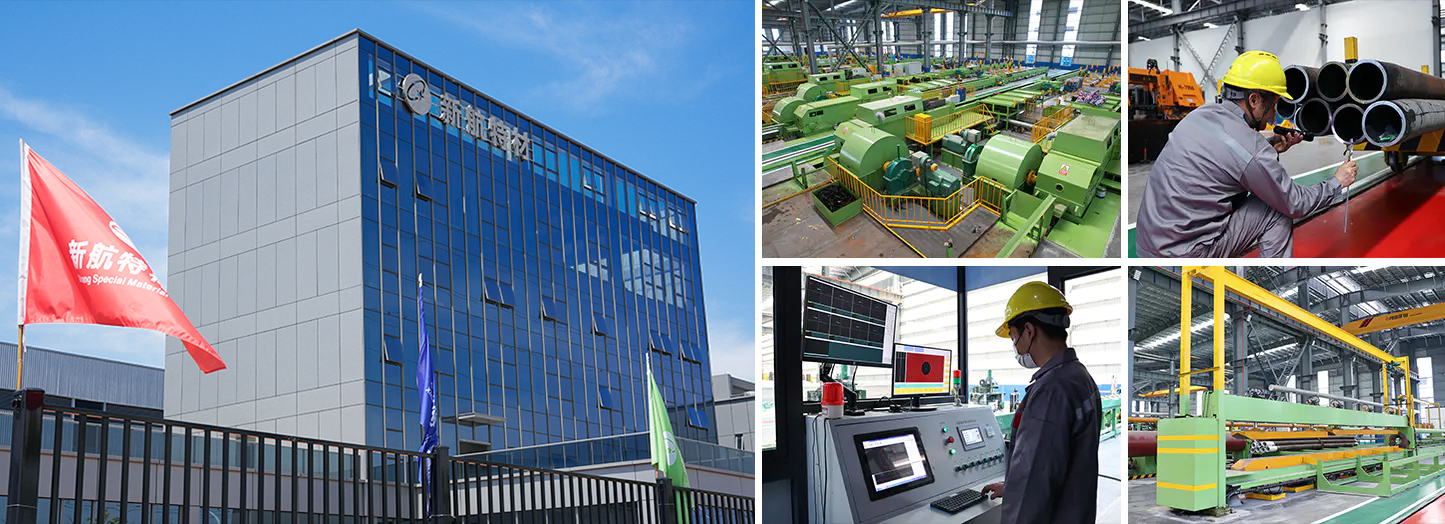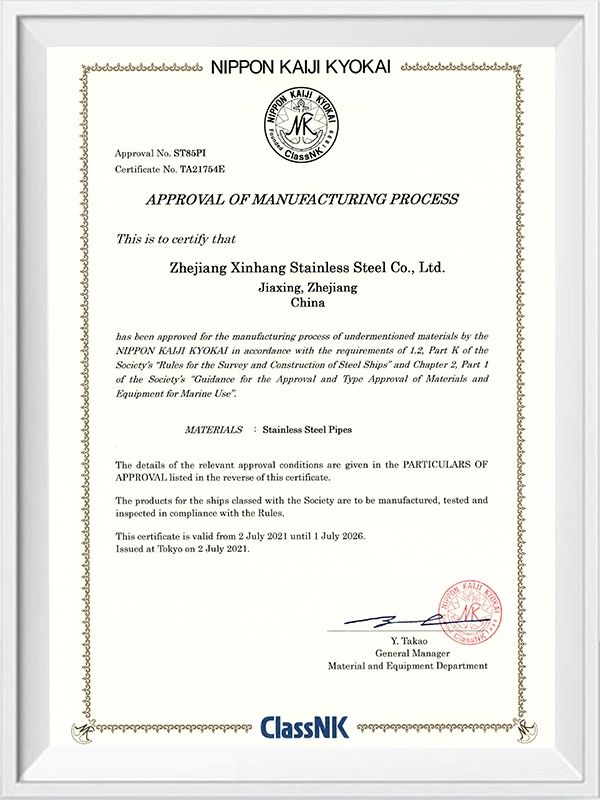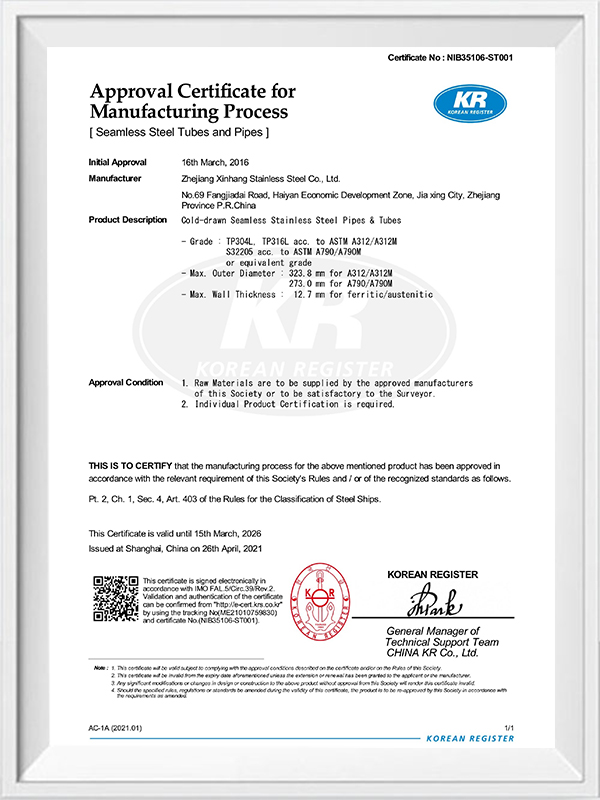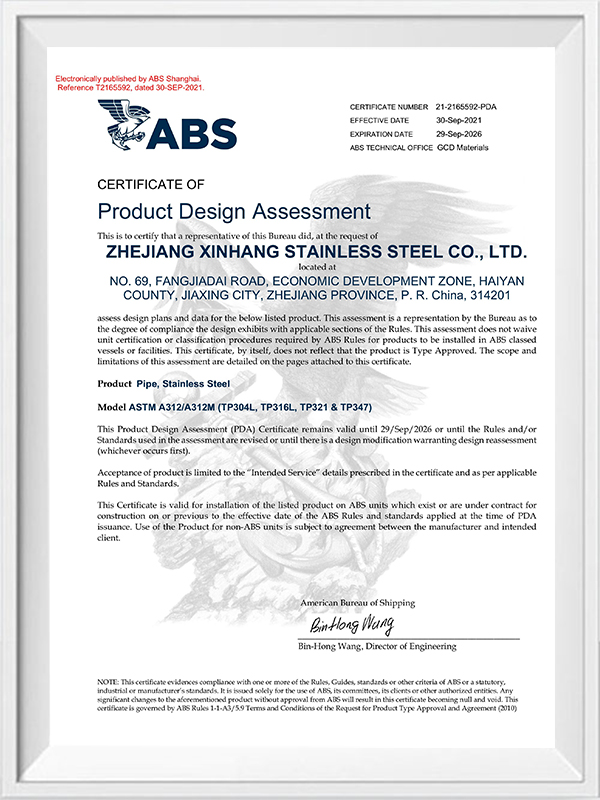

Xinhang Special Material Co., Ltd. Hangzhou Branch is China Stainless Steel Weld Neck Flanges Manufacturers and Stainless Steel Weld Neck Flanges Factory, founded in 2007 and moved to Longyou Economic Development Zone, Zhejiang Province, in 2022. It covers an area of 130,000 square meters, more than 30 production lines, 300 workers, 20 R&D people, 30 inspection people and an annual output of 50,000 tons.
It has passed ISO9001:2008 quality management system, PED 97/23/EC EU Pressure Equipment Directive certification, China Special Equipment Manufacturing License (Pressure Tube) TS certification, ASME certification, provincial enterprise standardization management system, ISO14000:2004 environment management system, cleaner production (green enterprise), and a series of certifications, as well as China Classification Society (CCS), American Bureau of Shipping (ABS), British Register of Shipping (LR), Deutsche Veritas (GL), Bureau Veritas Society (BV), Det Norske Veritas (DNV), and Korean Register of Shipping (KR) factory certification.
The main products include stainless steel pipes, pipe fittings, flanges, valves, etc., which are widely used in petroleum, chemical industry, nuclear industry, smelting, shipbuilding, pharmaceuticals, food, water conservancy, electric power, new energy, mechanical equipment, and other fields. The company adheres to the corporate tenet of "quality for survival, reputation for development" and wholeheartedly serves every customer to create a win-win situation.




Introduction to Alloy Steel Alloy steel is a type of steel that is made by combining carbon steel wi...
View MoreMass Density of Mild Steel: Basics and Practical Importance The mass density of mild steel is a fund...
View MoreUnderstanding Stress Proof Steel Stress proof steel is a type of alloyed steel engineered to resist ...
View MoreIntroduction to Low Alloy Steel Material Low alloy steel material is a type of steel that contains a...
View MoreOverview — what "weight per cubic inch" means for stainless steel "Weight per cubic inch" is simply ...
View MoreCan stainless steel weld neck flanges be used in high-pressure piping systems?
Stainless steel weld neck flanges stand as stalwarts in the realm of piping systems, revered for their robustness, reliability, and resilience in demanding industrial applications. One pressing question often arises among engineers and project managers: Can stainless steel weld neck flanges be used in high-pressure piping systems? Let's delve into the intricacies of this vital query.
At the heart of the matter lies the unique design of stainless steel weld neck flanges. These flanges boast a distinctive structure featuring a long tapered hub that seamlessly merges with the pipe, providing unparalleled reinforcement and support. It's this very design that renders them exceptionally well-suited for applications where operating pressures soar to substantial levels.
High-pressure environments exert immense forces on piping systems, demanding components that can withstand the rigors of such conditions without compromise. Stainless steel, renowned for its exceptional strength and corrosion resistance, emerges as the material of choice for weld neck flanges destined for high-pressure duties. This formidable alloy not only fortifies the structural integrity of the flanges but also shields them against the corrosive onslaught of harsh operating environments.
Picture a scenario where a petrochemical plant requires a piping system to withstand the punishing pressures of transporting volatile substances. Here, stainless steel weld neck flanges stand as sentinels, steadfastly anchoring the connections between pipes with unwavering strength and reliability. Their robust construction and corrosion-resistant properties ensure uninterrupted operation, safeguarding both personnel and assets against the perils of leaks or ruptures.
However, the successful integration of stainless steel weld neck flanges into high-pressure piping systems hinges not only on their inherent attributes but also on meticulous selection, installation, and maintenance practices. Engineers must carefully evaluate factors such as flange size, class, and material grade to align with the specific requirements of the application and operating conditions.
Installation procedures demand precision and expertise to achieve leak-free connections and optimize the performance of the flanges under high-pressure loads. Employing appropriate welding techniques and adhering to industry standards play pivotal roles in ensuring the integrity of the welds and, by extension, the entire piping system.
Furthermore, ongoing maintenance and inspection protocols are imperative to detect and rectify any signs of wear, damage, or corrosion that could compromise the effectiveness of the flanges in high-pressure environments. Regular inspections, coupled with proactive maintenance measures, serve as bulwarks against unforeseen failures and uphold the reliability of the piping system.
How do you inspect stainless steel weld neck flanges for defects or damage?
Inspecting stainless steel weld neck flanges for defects or damage is a critical aspect of ensuring the integrity and safety of high-pressure piping systems. Here's a comprehensive guide on how to conduct such inspections:
Visual Inspection: Begin by visually examining the weld neck flanges for any visible signs of damage, such as cracks, deformations, or corrosion. Inspect the entire surface, including the weld area, hub, and flange face, under adequate lighting conditions.
Dimensional Inspection: Verify that the dimensions of the weld neck flange align with the specified standards and requirements. Measure key dimensions such as diameter, thickness, and length to ensure they meet the prescribed tolerances.
Surface Finish Examination: Assess the surface finish of the flange face to ensure it meets the required smoothness and flatness standards. Any irregularities or imperfections could compromise the effectiveness of the flange gasket and lead to leakage.
Non-Destructive Testing (NDT):
Ultrasonic Testing (UT): Utilize ultrasonic waves to detect internal defects, such as cracks or inclusions, in the weld and base material.
Radiographic Testing (RT): Employ X-rays or gamma rays to inspect the internal structure of the weld for defects, discontinuities, or lack of fusion.
Magnetic Particle Testing (MT): Apply a magnetic field and magnetic particles to detect surface and near-surface defects, such as cracks or laps, in the weld and base material.
Dye Penetrant Testing (PT): Apply a penetrant liquid to the surface of the weld and observe for indications of surface-breaking defects after excess penetrant is removed.
Pressure Testing: Conduct hydrostatic or pneumatic pressure testing to assess the stainless steel weld neck flange's ability to withstand the intended operating pressures without leakage. Ensure that the pressure testing procedure complies with relevant standards and specifications.
Material Analysis: Perform material analysis, such as chemical composition testing and mechanical property testing, to verify the integrity and quality of the stainless steel material used in the weld neck flanges.
We'll never share your email address and you
can opt out at any time, we promise.